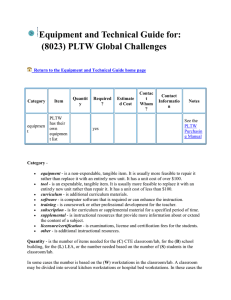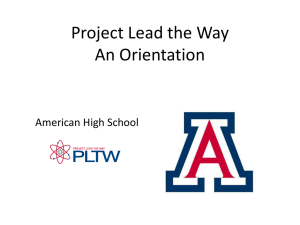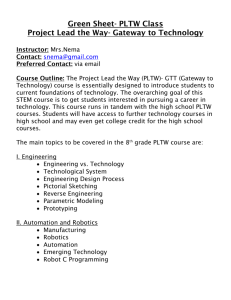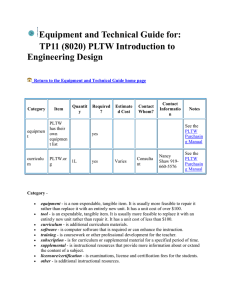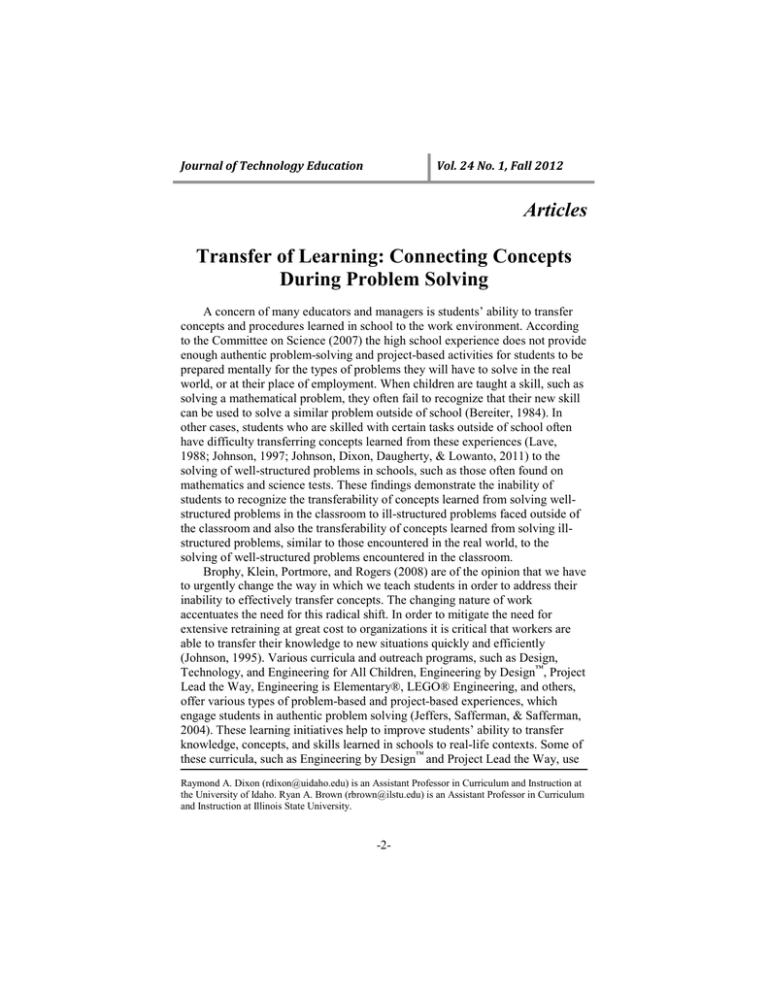
Journal of Technology Education
Vol. 24 No. 1, Fall 2012
Articles
Transfer of Learning: Connecting Concepts
During Problem Solving
A concern of many educators and managers is students’ ability to transfer
concepts and procedures learned in school to the work environment. According
to the Committee on Science (2007) the high school experience does not provide
enough authentic problem-solving and project-based activities for students to be
prepared mentally for the types of problems they will have to solve in the real
world, or at their place of employment. When children are taught a skill, such as
solving a mathematical problem, they often fail to recognize that their new skill
can be used to solve a similar problem outside of school (Bereiter, 1984). In
other cases, students who are skilled with certain tasks outside of school often
have difficulty transferring concepts learned from these experiences (Lave,
1988; Johnson, 1997; Johnson, Dixon, Daugherty, & Lowanto, 2011) to the
solving of well-structured problems in schools, such as those often found on
mathematics and science tests. These findings demonstrate the inability of
students to recognize the transferability of concepts learned from solving wellstructured problems in the classroom to ill-structured problems faced outside of
the classroom and also the transferability of concepts learned from solving illstructured problems, similar to those encountered in the real world, to the
solving of well-structured problems encountered in the classroom.
Brophy, Klein, Portmore, and Rogers (2008) are of the opinion that we have
to urgently change the way in which we teach students in order to address their
inability to effectively transfer concepts. The changing nature of work
accentuates the need for this radical shift. In order to mitigate the need for
extensive retraining at great cost to organizations it is critical that workers are
able to transfer their knowledge to new situations quickly and efficiently
(Johnson, 1995). Various curricula and outreach programs, such as Design,
Technology, and Engineering for All Children, Engineering by Design™, Project
Lead the Way, Engineering is Elementary®, LEGO® Engineering, and others,
offer various types of problem-based and project-based experiences, which
engage students in authentic problem solving (Jeffers, Safferman, & Safferman,
2004). These learning initiatives help to improve students’ ability to transfer
knowledge, concepts, and skills learned in schools to real-life contexts. Some of
these curricula, such as Engineering by Design™ and Project Lead the Way, use
Raymond A. Dixon (rdixon@uidaho.edu) is an Assistant Professor in Curriculum and Instruction at
the University of Idaho. Ryan A. Brown (rbrown@ilstu.edu) is an Assistant Professor in Curriculum
and Instruction at Illinois State University.
-2-
Journal of Technology Education
Vol. 24 No. 1, Fall 2012
engineering principles and design as a framework for learning STEM concepts
and processes (Nathan, Tran, Phelps, & Prevost, 2008). The ontology of
engineering education provides a framework that supports the acquisition of a
wide range of knowledge and skills that are associated with STEM.
The low performance of students on standardized tests, however, is still a
major concern for educators and the general public. While these curricula offer
more authentic problem solving, it is not clear if these experiences also allow
students to connect learned concepts to the solving of mathematics and science
standardized test items. This study focuses on one such curriculum—Project
Lead the Way (PLTW)—a multi-year, problem-based/project-based preengineering curriculum that is used by some schools in their engineering and
technology education program (Tran & Nathan, 2010). Since a large portion of
the PLTW objectives emphasize content from mathematics and/or science
standards (Project Lead the Way [PLTW], 2008), it is the authors view that
students should be able to demonstrate the ability to connect concepts learned
from engaging in PLTW curriculum activities to the solving of mathematics and
science test problems in the classroom.
Purpose of the Study
The purpose of this study is to determine if PLTW students are able to
better transfer mathematics, science, and design concepts from one situation to
another than students who have not taken the PLTW courses and the extent to
which students are able to make connections to concepts learned in the PLTW
courses to concepts that they are required to use when solving standardized test
problems. This study is based around the following research questions:
• Is there a relationship between the mathematics, science, and design
performance of students and the number of PLTW courses they have
taken? Is there a difference in the mathematics, science, and design
performance of students who have taken PLTW courses and those who
have not taken a PLTW courses?
• To what extent are students able to associate concepts learned in the
PLTW curriculum with concepts required to solve mathematics,
science, and design problems?
Transfer of Learning
There are several factors that affect learning transfer. These include whether
students understand or simply memorize knowledge, the amount of time spent
on learning the task, the amount of deliberate practice that is done beyond
learning the task, the motivation of the student, how the problem is represented,
the transfer conditions, and the metacognition of the solver (Dweck, 1989;
Ericsson, Krampe, & Tesch-Romer, 1993; Johnson et al., 2011; Palinscar &
Brown, 1984; Singley & Anderson, 1989).
-3-
Journal of Technology Education
Vol. 24 No. 1, Fall 2012
Two broad categories of transfer are described in the literature—near
transfer and far transfer. According to Johnson (1995) near transfer occurs when
students apply their knowledge and skills in situations and contexts that are very
similar to those in which the learning occurred. In contrast, a far transfer occurs
when a skill is performed in a context that is very different from the context in
which the skill was learned. The opportunities for far transfer in problem solving
within schools are understandably not as regular as the opportunities for near
transfer. Far transfer is more difficult “because students must deliberately
analyze the situation in order to recall the rules or concepts that are needed to
apply their knowledge and skill in that particular situation (Salomon, 1988)” (p.
34).
Good and poor problem solvers differ in their recall of information from
previously encountered problems and by extension their ability to transfer
concepts to the target problem. This difference exists because poor problem
solvers tend to remember surface similarities between problems, while good
problem solvers remember underlying conceptual structures that make two
problems similar although they have different surface features (Sutton, 2003).
This ability of good problem solvers makes it easier to transfer concepts learned
in other domains or from solving other types of problems because of their
conscious effort to abstract knowledge and concepts from one context for
application to another (Johnson, 1995). Cognitive research shows that the
organization of learning and how new learning relates to what a student already
knows are the strongest predictors of how well a student will transfer knowledge
(National Research Council, 2000). Schunn and Silk (2011) articulated,
however, that in science and engineering students often “lack relevant
conceptual frameworks or have frameworks that are not developed enough to
support new learning adequately” (p. 9). The absence of such frameworks makes
it difficult for students to connect and apply other knowledge where relevant.
Key Components in the Learning Transfer Process
Sutton (2003), stated that “the problem-solving process involves several
aspects from which three major facets tend to emerge: the solver’s
representation of the problem, the solver’s background experiences, and the
solver’s understanding of the problem” (p. 56). The problem solving process
begins as soon as the problem solver generates enough information about the
problem space to gain an understanding of the problem. Often, the problem
solver is able to associate concepts from previous experience to solving a similar
problem. This association with analogous concepts may originate from some
form of prompting about the similarity, or the two problems may share similar
surface features that the problem solver recognizes (Gick & Holyoak, 1980;
Needham & Begg, 1991). Sometimes the problem provides retrieval cues that
permit access to relevant clues that in turn aid in the transfer of concepts and
knowledge. According to Perfetto, Bransford, and Franks (1983), most problem-4-
Journal of Technology Education
Vol. 24 No. 1, Fall 2012
solving situations involve cases in which problem solvers are uninformed. They
are not provided with any clues or prompt about previously learned concepts
that can aid in the solution, and so they engage in self-generation of potential
answers to the problem solution. That being the case, it would seem relevant that
studies also address the question of how information can be transferred under a
“condition in which students are not explicitly informed about a particular
acquisition context that is relevant to problems they confront” (p. 31).
Representation. Representation in the problem-solving process refers to
how the solver mentally represents the problem. The solver’s representation of
the problem is directly related to his or her existing knowledge structure of the
content of the problem. The advantages of abstract problem representations have
been studied in the context of algebra word problems. “Students who were
trained on specific task components without being provided with the principles
underlying the problems, could do specific tasks well but they could not apply
their learning to new problems. By contrast, the students who received abstract
training showed transfer to new problems that involved analogous relations”
(National Research Council, 2000, p. 63). Research also shows that engaging
students in the solutions of different types of problems in different contexts can
enhance transfer by enabling learners to think flexibly about complex domains
(Spiro, Feltovitch, Jackson, & Coulton, 1991). Various types of mental
representations are used by students and experts alike in order to understand a
problem and to facilitate transfer, particularly, but not limited to, representations
such as analogies, metaphors, and propositions are used in the solving of illstructured problems such as engineering design (Hey, Linsey, Agogino, &
Wood, 2008; Lewis, 2008; Paivio, 1990).
Understanding. A student’s comprehension of a problem and his or her
ultimate ability to transfer concepts learned previously to the current problem is
inextricably linked to his or her ability to properly represent the problem.
Embedded within each representation are concepts that the solver deems
analogous to the problem being tackled, and he or she will transfer these
concepts to arrive at a satisfying solution. A philosophical underpinning of
programs that integrate the STEM domains is the learning of concepts in one
domain, such as science or technology, will facilitate the learning of concepts in
other domains, such as mathematics or engineering. Students who can identify
the connection between concepts across domains will likely demonstrate an
understanding of the problem. While a superior understanding of a problem is
demonstrated by the transfer of concepts, knowledge, or processes without
prompting, sometimes the use of prompting is necessary. According to Gick and
Holyoak (1980; 1983) and Perfetto et al. (1983), prompting can dramatically
improve the rate of transfer in problem solving.
A good understanding of the problem will also be reflected in how solvers
use metacognitive skills. Metacognition refers to how problem solvers are able
to self-regulate the strategies that they use. When students are cognizant of the
-5-
Journal of Technology Education
Vol. 24 No. 1, Fall 2012
requirements of a problem, they will more proficiently focus on critical elements
of the problem, connect or abstract common themes from previous problem
solving episodes or learning experience, and evaluate their progress towards the
right solution for well-structured problems or a good solution for ill-structured
problems (Sutton, 2003; National Research Council, 2000).
Experiences. Each student’s experience differs. Different individuals have
different conceptual knowledge and will make different associations to their
knowledge. Exposure to the constraints and affordances of a particular context
in which a problem exists will invariably influence the way in which the student
represents a problem in a similar context. According to Sutton (2003), the
solver’s prior experience helps to establish an understanding of the problem. The
process of understanding is iterative, and full understanding is often complex.
When the problem solver completely understands the problem and its underlying
structure, then transfer to similar situations can occur.
Students bring a wealth of knowledge to each learning situation and,
without specific guidance from teachers, may fail to connect everyday
knowledge to subjects taught in schools (National Research Council, 2000). As
students’ metacognitive skills develop, their ability to make connections to their
learning experiences in school and beyond the walls of the classroom becomes
more self-regulated and automatic when solving problems. The nature of
activities within problem-based and project-based curricula can aid in
authenticating the problem-solving engagements by students so that both near
and far transfer becomes more fluid. Transfer between tasks is a function of the
similarity of transfer tasks and learning experiences. Transfer is therefore
affected by the context of the original learning; so, people can learn in one
context and yet fail to transfer in other contexts. When students are exposed to
multiple contexts in their instructions that include examples that demonstrate a
wide application of what is being taught, they develop a flexible representation
of knowledge and are likely to abstract the relevant features of concepts that
make two unique problem scenarios similar (Gick & Holyoak, 1983; Spiro,
Vispoel, Schmitz, Samarapungavan, & Boerger, 1987).
One view of learning transfer is that students find it difficult to transfer
concepts that they learn in schools to the real world because education simplifies
material to make it easier to teach (Spiro et al., 1991). However, problem-based
learning may not suffer from a lack of context or an oversimplification of
content. There is a growing sentiment that learning of this form, which utilizes
problem-based and project-based activities, can enhance students’ general
learning transfer and problem-solving skills (Hmelo-Silver, 2004). For example,
Lachapelle and Cunningham (2007) found that Engineering is Elementary, one
of the largest elementary engineering curricula that focuses on integrating
engineering with reading literacy and existing science topics in the elementary
grades, can improve students’ knowledge and comprehension of general
engineering, technology, and science concepts. Mahalik, Doppelt, and Schunn
-6-
Journal of Technology Education
Vol. 24 No. 1, Fall 2012
(2008), in an examination of the effectiveness of design-based instruction, found
that the design-based approach for teaching middle school science is associated
with improvement in science achievement, engagement, and retention of science
concepts.
Project Lead the Way
PLTW is a non-profit organization that works with public schools, the
private sector, and higher education to increase the quantity and quality of
engineers and engineering technologists by providing high school students with
engaging pre-engineering activities. They provide curricula for both middle and
high schools. The standard-based pre-engineering curriculum, Pathway to
Engineering, is designed for high schools. It challenges students to solve realworld engineering problems by applying their knowledge and skills in
mathematics, science, and technology. The four year engineering sequence
consists of eight hands-on courses; two are foundation courses (Introduction to
Engineering Design and Principles of Engineering) five are specialized courses
(Aerospace Engineering, Biotechnical Engineering, Civil Engineering and
Architecture, Computer Integrated Manufacturing, and Digital Electronics) and
one is a capstone course (Engineering Design and Development) (PLTW, 2012).
A recent study by Tran and Nathan (2010) investigated the relationship
between pre-college engineering studies and student achievement in
mathematics. Their findings (using multilevel statistical modeling with 140
students nested within teachers) showed that while students gained in
mathematics and science achievements up to tenth grade, students enrolled in
PLTW foundation courses showed significantly smaller math assessment gains
than those in a matched group that did not enroll, and there was no measurable
advantage on science assessments when controlling for prior achievement and
teacher experience.
Another study conducted by PLTW (2008) described the alignment of
learning activities in PLTW curriculum, Introduction to Engineering Design
(IED), with mathematics and science standards. The study showed that,
generally, a large proportion of the objectives in the IED course emphasizes
content from the mathematics and/or science standards, a large proportion of the
objectives dually emphasize mathematics and science content, and objectives
across the curriculum that emphasize mathematics and science expect students
to employ concepts and skills and use short-term strategic thinking. According
to PLTW, the need to show the relevance of the interconnection of STEM to
what students are learning is more important than ever in order to excite more
students about STEM careers.
-7-
Journal of Technology Education
Vol. 24 No. 1, Fall 2012
Method
An embedded design mixed method framework (Creswell, 2008) was used
as the method of this study. Mixed method studies that utilize the embedded
design gather both qualitative and quantitative data, but “one form of data plays
a supportive role to the other form of data” (Creswell, 2008, p. 558). In this
study the quantitative data was given priority as the main source of data, and the
qualitative data played a supportive role. This study utilized a non-experimental
design, as it used intact classrooms and no attempt was made to manipulate the
variables or treatment.
Participants
A convenience sample was selected. The participants were students at a
Midwestern high school. The school of nearly 1,500 students is located in a
rapidly growing metropolitan area on the fringe of a large city. According to the
public data regarding the school, the student population is nearly 90 percent
white, only two percent of the students in the district live below the poverty line,
and upon graduation 90 percent of the students attend a post-secondary
institution. The Engineering/Technology Education department has three full
time teachers and offers a wide range of traditional technology education
courses as well as six PLTW courses (Introduction to Engineering Design,
Principles of Engineering, Aerospace Engineering, Civil Engineering and
Architecture, Computer Integrated Manufacturing, and Engineering Design and
Development). Participation in this study was offered to two upper level PLTW
classes (Civil Engineering and Architecture and Engineering Design and
Development) and two advanced mathematics and science classes (AP Physics
and AP Calculus).
Thirty-eight students from PLTW courses and 25 mathematics and science
students obtained parental consent, provided personal assent, and participated in
the study. Group 1 (N = 25), referred to as non-PLTW students, consisted of
students who had not taken any PLTW courses. Of this amount, 5 were juniors
and the remaining 20 were seniors. All juniors had previously completed
mathematics courses such as Algebra I, Algebra II, Geometry, and
Trigonometry, and one student had completed a statistics course. Science
courses completed by juniors included biology, chemistry, and physics. One of
the juniors completed an additional AP Physics course, and another completed
an additional AP Biology course. The seniors had taken additional mathematics
courses such as Pre-Calculus, Calculus, and Probability and Statistics.
Additional science courses taken by seniors include AP Chemistry, Zoology,
Microbiology, Anatomy, AP Environmental Science, Biotechnology, and
Astronomy.
Group 2 (N = 38), referred to as PLTW students, consisted of students who
had completed the mathematics and science courses required of PLTW (or some
of the courses, in the case of juniors and sophomores) and also had taken one or
-8-
Journal of Technology Education
Vol. 24 No. 1, Fall 2012
more PLTW courses. Three students were sophomores, 17 were juniors, and 18
were seniors. Five students had taken two PLTW courses, 18 had taken three
PLTW courses, 14 had taken four PLTW courses, and one student had taken
five PLTW courses.
The groups’ sample sizes were well within the range that is required for
Pearson’s correlation to detect significant correlation between two variables and
for an independent t-test to detect a significant difference in students’ scores
with a statistical power of .80. According to Cohen (1988), a Pearson’s
correlation test requires a minimum sample size of twenty-one for a large effect
size and a one tailed alpha of .05. Also, for an independent t-test, a minimum
sample size of twenty-one cases per group is needed for a large effect size and a
one tailed alpha of .05.
Data Collection and Analysis
All students that consented to participate in the study were asked to
complete a test instrument that was divided in three sections—mathematics,
science, and design. The mathematics and science sections each consisted of
five test items taken from past standardized tests. The items were then vetted by
four teachers, two from mathematics and two from the sciences, to ensure
consistency in the difficulty level of the test items. Answer sheets were prepared
for each test item by a mathematics and science teacher. The design problem
represented an ill-structured engineering problem that required students to use
their knowledge of math, science, and technology to solve. The problem was
adopted from an engineering design textbook. Several possible solutions were
provided by the design textbook. In addition to answering the questions, the
PLTW students were asked to write down the PLTW concepts or activity that
best equipped them to answer each particular question. The non-PLTW students
were not asked this question. Completed tests were scored by two teachers using
the answer sheets that were provided.
Numerical scores were then assigned to each test section and calculated to
determine an overall score. SPSS analysis of the scores found the distributions
to be normal and of similar variance. A Pearson’s correlation test was then run
to determine if a relationship existed between the number of PLTW courses that
a student had taken and their performance on the overall test and the design,
mathematics, and science components of the test. Then an independent t-test
was performed to determine if a significant difference existed between the
means of the PLTW students and the non-PLTW students on the overall test and
each subsection. Lastly, the qualitative data was analyzed to determine if
students were able to connect the concepts that were presented in the instrument
with the courses in which they were presented with those concepts.
-9-
Journal of Technology Education
Vol. 24 No. 1, Fall 2012
Findings
We found significant relationships between the number of PLTW courses
students took and students’ performance in design score and total score. Also,
there was no significant difference in mathematics and science performance
between PLTW and non-PLTW students. PLTW students, however, performed
significantly better on the design component of the test.
Pearson’s correlation analysis shows a significant positive correlation
between the number of PLTW courses taken and the students’ score on the
design component of the test (r = .33, ρ < 0.05). There was a significant positive
correlation between the number of PLTW courses taken and students’ combined
or total score on the test (r = .36, ρ < 0.05). In other words, the scores of the
students who have taken more PLTW courses increased significantly on the
design component of the test and on the total score on the test. Although these
variables have statistically significant relationships, this relationship is
considered weak because the number of PLTW courses only explains 11% and
13% variances of the design scores and the total scores respectively. In other
words 89% and 87% of the variances in the design scores and total scores
respectively can be attributed to other factors.
Table 1
Correlation Matrix (N = 38)
# of
Total
Design
PLTW
Score
Score
# of PLTW
1.00
Total Score
.35*
1.00
Design Score
.33*
.59**
1.00
Math Score
.19
.68**
.15
Science Score
.18
.72**
.17
**Correlation is significant at the 0.01 level (1-tailed)
*Correlation is significant at the 0.05 level (1-tailed)
Math
Score
Science
Score
1.00
.17
1.00
There was also a significant positive correlation between students’ total scores
and their performance on the mathematics (r = .68, ρ < 0.01), science (r = .72, ρ
< 0.01), and design (r = .59, ρ < 0.01) components of the test (see Table 1).
The results of the independent t-test shows a significant difference (t (df = 61)
= 1.933; ρ < 0.05) between the students who have taken one or more PLTW
courses and those students who have not taken any PLTW courses on the design
component of the test. The PLTW students reported statistically significant
higher scores on the design component of the test (x̄ = 37.82) than those who
have not done the PLTW course (x̄ = 26.72); a mean difference of 11.10. There
was no significant difference in the students who have taken PLTW courses and
those who have not on the mathematics component (t (df = 61) = -1.43; ρ > 0.05),
-10-
Journal of Technology Education
Vol. 24 No. 1, Fall 2012
science component (t (df = 61) = 0.009; ρ > 0.05), and overall score on the test (t (df
= 0.019; ρ > 0.05).
= 61)
Table 2
Results of Independent T-Test—DESIGN SCORE of Non-PLTW and PLTW
Variable
N
x̄
SD
t
ρ*
DESIGN SCORE
Non-PLTW
PLTW
*One-tailed ρ value
25
38
26.72
37.82
21.49
22.79
1.93
0.029
Connecting Concepts
A qualitative assessment was done of all the PLTW students with scores at
and above the 50th percentile (P50, N = 22) to determine the extent they were
able to connect concepts that were learned from the PLTW curriculum to
concepts they used to solve mathematics, science, and design items on the test.
Not all students were able to explicitly identify concepts that related to the
question that they were solving; however, sometimes they could remember the
PLTW, mathematics, or science course in which they were introduced to the
concept.
Figure 1
Percentage of concepts that were connected with test items
In general, the students with higher scores were able to make more connections
to concepts learned from the PLTW curriculum. Figure 1 illustrates that 16% of
the concepts identified in the mathematics section, 17% in the science section,
and 96% in the design section of the test were connected with concepts that the
students attributed to PLTW courses.
-11-
Journal of Technology Education
Vol. 24 No. 1, Fall 2012
Table 3
Connections to Concepts and Courses Made by Students
Test
Connected Concepts
Connected Courses
Component
Science
Electricity, Circuits, Heat transfer,
IDK, POE, CEA,
Items
Beam deflection, Beam
Chemistry, Physics,
calculation, Kinematics, Truss
Integrated Chemistry,
evaluation, V = IR, Velocity,
Civil Engineering, AP
Physics, Aerospace.
Mathematics
Items
Percentage, Proportion, SOH
CAH TOH, Area width & Length,
Pythagoras theorem,
trigonometry, Plug and play,
Percentage change, Percentage
error, Algebra, geometry, Law of
sine and cosine, Volume
IE, POE, IDK, Middle
School Math, AP Physics,
Statistics, Physics
Design Item
Trigonometry, Problem solving,
Calculus, Electricity, General
math and logic, Material
efficiency, Share cost projection,
Design process, Geometry,
POE, IED, CEA, EDD,
Physics,
Table 3 lists the concepts and courses that students were able to make
connection to when solving the mathematics, science, and design test items.
Note that abbreviated concepts typically refer to courses taken in the PLTW
curriculum (e.g., POE-Principle of engineering; EDD-Engineering design and
development; IED-Introduction to engineering design; CEA- Civil engineering
and architecture).
Discussion and Conclusions
Because a convenience sample was used, generalized statements about
students who take and those who do not take the PLTW courses cannot be made.
The findings, however, offer some insight that can be beneficial to engineering
and technology educators when teaching STEM concepts. In addition, the
authors believe that higher scores were possible if students were given time to
prepare for the test, as is usually the norm in schools. The intent, however, was
to examine students’ ability to make connections under impromptu test
conditions.
A small percentage of the students in this study who performed above the
50th percentile were able to connect mathematics and science concepts (16%
and 17% respectively) learned in the PLTW curriculum to the problems they
-12-
Journal of Technology Education
Vol. 24 No. 1, Fall 2012
were solving. The fact that students were able to identify these concepts means
that they believed that these concepts were present in the PLTW courses that
they had taken. Their recognition of the concepts may have allowed for greater
comprehension of the problem, which likely led to more accurate solutions.
While the PLTW students’ performance was significantly better on the
design question, the relationship between the number of PLTW courses taken
and the scores on the design problems was weak. A possible explanation resides
in the nature of the design problem, which required that students also draw
heavily on their understanding of mathematics and science concepts. Therefore,
topics covered in mathematics and science classes, likely, played a major part in
the students’ ability to solve the design problem.
There was no significant difference in the overall performance of students
in both groups on the mathematics and science items. This indicates that both
groups ability to make connection to concepts from previous learning
experiences when solving standardized mathematics and science test items are
similar. Therefore, it can be assumed that both groups functioned at similar
levels of understanding. The PLTW students, however, functioned at a superior
level on the design question and the connections they made with mathematics
and science concepts. Their ability to make more connections may also be
indicative of superior metacognition or self-regulation. However, a research
design that uses think-aloud protocols would better provide that type of
evidence. Because of their higher scores on this component of the test, the
PLTW students accrued higher scores on the total test.
The findings from this study are in some ways consistent with Hartzler’s
(2000) findings. She conducted a meta-analysis across 30 individual studies of
the effects of integrated instruction on students’ achievement. She concluded
that students in integrated curricula programs outperform students in traditional
class on standardized test and state testing programs. In this study, there was no
difference in the performance of non-PLTW students and PLTW students on the
standardized mathematics and science items. However, the PLTW students’
overall performance on the design question was higher.
Since Hartzler’s (2000) findings, more intentional efforts are being made to
integrate more mathematics and science in project-based and problem-based
curricula. The national demand for a STEM workforce makes integrated
curricula an essential feature in education. The pedagogy of integrated STEM,
however, is still in a nascent stage and more research is needed to clearly define
the best strategy to optimize learning by students.
Teaching and reinforcing critical STEM concepts can be very challenging
for many engineering and technology educators. While engineering and
technology educators want their students to learn STEM, according to Crismond
(2011, 2006), their focus is also for students to gain competency in engineering
design. Therefore, they would emphasize engineering design concepts such as
optimization, tradeoff, troubleshooting, and meeting criteria within prescribed
-13-
Journal of Technology Education
Vol. 24 No. 1, Fall 2012
constraints. In order to increase the likelihood of students connecting and
transferring STEM concepts in problem solving, engineering and technology
educators will need to teach with the intent to improve students’ understanding
of STEM concepts—rather than teaching primarily for the understanding of
engineering concepts. Technology teachers, however, “often lack the
pedagogical content knowledge that would make reviewing or re-teaching topics
from STEM disciplines efficient and effective” (Crismond, 2011, p. 299).
Sanders (2009) admitted that it is difficult to prepare a teacher that is
competent in all three bodies of knowledge, given the volume of content
knowledge necessary to be an effective science, mathematics or technology
educator. Assuming Sanders’ views represent a more realistic assessment of the
challenge to prepare STEM teachers, engineering and technology educators will
need to work collaboratively with mathematics and science teachers to identify
and teach critical STEM concepts that the engineering and technology teacher
may lack the competency to teach. This will reinforce previously learned
concepts and increase the likelihood of students learning and transferring
difficult, abstract mathematics and science concepts and procedures. This
pedagogical approach is not without its challenges, as students may still
compartmentalize their knowledge. Also, it is often difficult logistically and in
terms of instructional timing for teachers across STEM discipline to collaborate
effectively (Crismond, 2011; Kimbell & Stables, 2008).
Admittedly, some educators may reason that students should be able see the
mathematics and the science in the engineering and technology that they teach.
But students may not readily recognize these relationships unless meaningful
activities are given to explicitly highlight these connections. As one young
machinist admitted at the recent NSF ATE conference in Washington, DC, he
did not see the relevance of trigonometry until a senior machinist showed him
how to use it to solve a particular machining problem. Similarly, students may
not metacognitively see the underlying links between STEM concepts and are
unable to transfer the knowledge when it is needed.
Students have to increase their reflective practice to aid their metacognition
and transfer of STEM concepts. Math and science concepts that are learnt during
engagement with ill-defined problems can easily be forgotten because students’
short term memory is “swamped with novel design decisions that must be made
and variables that must be considered” (Crismond, 2011, p. 240). The
engineering and technology teacher can give students activities that require them
to reflect on pertinent STEM concepts—increasing their likelihood of
remembering—either in groups or individually and then present their
understanding to the class. Students can consult with their mathematics and
science teachers, the World Wide Web, libraries, and other learning resources
that can aid them in the reflective process. As Johnson (1997) purported,
reflective introspection is necessary for quality learning and transfer, even if
instruction occurs in rich contexts and involves interaction with peers.
-14-
Journal of Technology Education
Vol. 24 No. 1, Fall 2012
Finally, this study represents a small scholarly endeavor, among many
others, to examine whether problem-based and project-based curriculums such
as PLTW can also help to improve students’ performance on math and science
tests. However, in order to make more generalized statement about the
effectiveness of these curricula, more robust experimental designs with larger
random samples are necessary. In addition, other curricula need to be studied to
determine their strengths and weaknesses in making explicit connections to
critical math and science concepts. Until student assessment methods are
modified to reflect less dependency on standardized tests, engineering and
technology educators will garner greater collaboration from math and science
teachers when the latter can see that engineering and design-based curriculums
does improve students’ ability to solve standardized test problems.
References
Bereiter, C. (1984). How to keep thinking skills from going the way of all frills.
Educational Leadership 42(1), 75-77.
Brophy, S., Klein, S., Portsmore, M., & Rogers, C. (2008). Advancing
engineering education in P-12 classrooms. Journal of Engineering
Education, 97(3), 369-387.
Crismond, D. (2006, October 9-12). Design 's different uses in science,
technology education, and math classrooms: Case studies from the US.
Paper presented at the 5th Gobal Colloquium n Engineering Education, Rio
de Janeiro, Brazil.
Crismond, D. (2011). Scaffolding strategies for integrating engineering design
and scientific inquiry in project-based learning environment. In M. Barak &
M. Hacker (Eds.), Fostering Human Development through Engineering and
Technology Education (pp. 55-74). Netherlands: Sense Publishers.
Cohen, J. (1988). Statistical power analysis for the behavioral sciences (2nd
ed.). New York, NY: Psychology Press.
Committee on Science (2007). Rising above the gathering storm:Energizing and
employing america for a brighter ecoonomic future. Washingston, DC:
National Academic Press.
Creswell, J. (2008). Educational research: Planning, conducting, and
evaulating quantitative and qualitative research. Upper Saddle River, NJ:
Pearson Prentice Hall.
Dweck, C. (1989). Motivation. In L. Lesgold, & R. Glaser, Foundations for a
Psychological Education (pp. 87-136). Hillsdale, N J: Erlbaum.
Ericsson, K. A., Krampe, R. T., & Tesch-Romer, C. (1993). The role of
deliberate practice in the acquisition of expert performance. Psychological
Review,100(3), 363-406.
Gick, M., & Holyoak, K. J. (1980). Analogical problem solving. Cognitive
Psychology,12, 306-355.
-15-
Journal of Technology Education
Vol. 24 No. 1, Fall 2012
Gick, M., & Holyoak, K. J. (1983). Schema induction and analogical transfer.
Cognitive Psychology,15, 1-38.
Hartzler, D. S. (2000). A meta-analysis of studies conducted on integrated
curriculum programs and their effects on students achievement. Doctoral
dissertation. Indiana University.
Hey, J., Linsey, J., Agogino, A. M., & Wood, K. L. (2008). Analogies and
metaphors in creative design. International Journal of Engineering
Education, 24(2), 283-294.
Hmelo-Silver, C. (2004). Problem-based learning: What and how do students
learn? Educational Psychology,16(3), 235-266.
Jeffers, A. T., Safferman, A. G., & Safferman, S. I. (2004). Understanding K–12
engineering outreach programs. Journal of Professional Issues in
Engineering Education and Practice. 130(2), 95-108. doi:
10.1061/~ASCE!1052-3928~2004!130:2~95!
Johnson, S. D. (1995). Transfer of learning. The Technology Teacher, 54(7), 3335.
Johnson, S. D. (1997). Learning technological concepts and developing
intellectual skills. International Journal of Technology and Design
Education, 7, 161-180.
Johnson, S. D., Dixon, R., Daugherty, J., & Lawanto, O. (2011). General versus
specific intellectual competencies: The question of learning transfer. In M.
Barak & M. Hacker (Eds.), Fostering Human Development through
Engineering and Technology Education (pp. 55-74). Netherlands: Sense
Publishers.
Kimbell, R., & Stables, K. (2008). Researching design learning: Issues and
findings from two decades of research and development. Lexington, KY:
Springer.
Lachapelle, C., & Cunningham, C. (2007). Engineering is elementary:
Children's changing understandings of science and engineering. In
Proceedings of the American Society for Engineering Education Annual
Confernence and Exposition. Honolulu, HI.
Lave, J. (1988). Cognition in Practice, New York, NY: Cambridge University
Press.
Lewis, T. (2008). Creativity in technology education: Providing children with
glimpses of their inventive potential. International Journal of Technology
and Design Education, 19(3), 255-258.
Mehalik, M. M., Doppelt, Y., & Schunn, C. D. (2008). Middle school science
through design-based learning versus scripted inquiry: Better overall science
concept learning and equity gap reduction. Journal of Engineering
Education, 97(1), 71-85.
National Research Council. (2000). How people learn: Brain, mind, experience
and school. Washington, DC: National Academy Press.
-16-
Journal of Technology Education
Vol. 24 No. 1, Fall 2012
Nathan, M. J., Tran, N., Phelps, L. A., & Prevost, A. (2008). The structure of
high school academic and pre-engineering curricula: Mathematics. In
Proceedings of the American Society of Engineering Education Annual
Conference and Exposition. Pittsburgh, PA.
Needham, D. R., & Begg, I. M. (1991). Problem-oriented training promotes
spontaneous analogical transfer: Memory-oriented training promotes
memory for training. Memory and Cognition, 19(6) 543–557.
Paivio, A. (1990). Mental representations. New York, NY: Oxford University
Press.
Palinscar, A., & Brown, A. L. (1984). Reciprocal teaching of comprehension
monitoring activities. Cognition and Instruction, 1, 117-175.
Perfetto, G. A., Bransford, J. D., & Franks, J. J. (1983). Contraints on access in a
problem solving context. Memory and Cognition, 11, 24-31.
Project Lead the Way. (2012). Path way to Engineering: High school
engineering program. Retrieved from http://www.pltw.org/ourprograms/high-school-engineering-program.
Project Lead the Way. (2008). Introduction to engineering design: Analysis of
cognitive levels of learning and mathematics and science content. Clifton
Park, NY: Project Lead the Way Inc.
Sanders, M. (2009). STEM, STEM education, STEM mania. The Technlogy
Teacher, 68(4), 20-26.
Schunn, C.D., & Silk, E. M. (2011). Learning theories for engineering and
technology education. In M. Barak & M. Hacker (Eds.). Fostering Human
Development through Engineering and Technology Education (pp. 55-74).
Netherlands: Sense Publishers.
Singley, A., & Anderson, J. R. (1989). The transfer of cognitive skill.
Cambridge, M A: Harvard University Press.
Spiro, R. J., Feltovitch, P. L., Jackson, M. L., & Coulton, R. L. (1991).
Cognitive flexibility, constructivism, and hypertext: Random access
instruction for advanced knowledge acquisition in ill-structured domain.
Educational Technology 31(5), 24-33.
Spiro, R. J., Vispoel, W. P., Schmitz, J. P., Samarapungavan, A., & Boerger, A.
E. (1987). Knowledge acquisition for application: Cognitive flexibility and
transfer in complex domains. (ERIC Document Reproduction Service No.
ED 287 155).
Sutton, M. J. (2003). Problem representation, understanding, and learning
transfer: Implications for technology education research. Journal of
Industrial Teacher Education, 40(4), 47-61.
Tran, N., & Nathan, M. (2010). Pre-college engineering studies: An
Investigation of the relationship between pre-college engineering studies
and student achievenment in science and mathematics. Journal of
Engineering Education, 92(2), 143-157.
-17-

